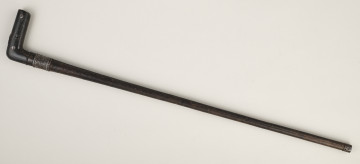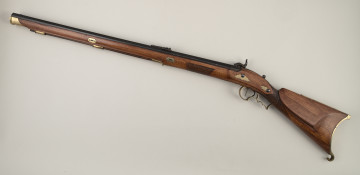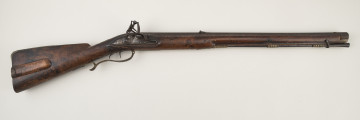
Shooting stick
20th century
Castle Museum in Łańcut
Part of the collection: Broń, instrumenty, varia
Arquebus with wheellock – the arquebus was the successor to the hand cannon, or gonne, the samopal, the hackbut; originally, in the 15th/ 16th centuries, with a smooth muzzle sized at 10-20 mm in diameter with a matchlock, with the muzzles becoming threaded in the 16th-17th centuries (improving the weapon’s aiming) and a new wheellock (less prone to failure than its predecessor). Our piece has a 16 mm calibre threaded muzzle, a wheellock and an interesting German-type butt with a broad flat area allowing the weapon to rest smoothly on the cheek when firing. The operation of the wheel lock entails the creation of sparks by striking a stone on a toothed steel plate. According to researchers, this type of lock was created in Germany around the year 1517, even though an ever higher number of researchers links the emergence of this type of lock with the person of Leonardo da Vinci and his surviving drawings. Other than his predecessor, the wheellock was always ready for use and was less susceptible to adverse weather conditions; it did have its shortcomings, however, such as: the complex design that increased production costs, or the need to keep safe a key for winding the lock (should it become lost, the weapon was rendered useless). This type of weapon was used by mounted infantry (the arquebusiers), firing from a mounted position, requiring much skill and a long training process. In the armed forces of the Polish-Lithuanian Commonwealth, it was classified as light foreign infantry, and the numbers were not very high; the organisation of these forces was like the cuirassiers of the West; these units were naturally armed with arquebuses as well as pairs of pistols and rapiers; these units also had defensive armours, composed of e. g. cuirasses, bevors, arm armour with gloves, with the head protected by an open helmet called the burgonet or pappenheimer helmet. This type of mounted unit emerged in the military of the Polish-Lithuanian Commonwealth in the times of Stephen Bathory, and remained until the 17th century. Initially during its existence ni Poland, arquebusiers constituted units mixed with lanciers and mounted Hussars, after lanciers were dissolved, and with the Hussars becoming independent, they constituted separate but rare units. An interesting fact is that until the 1620s, arquebusier units, despite great differences, were counted among the Hussars. The collection at our castle, beside the arquebus, includes a compilation of arquebus armours from the 16th-17th centuries.
Author / creator
Dimensions
height: 92 cm, width: 9 cm
Object type
Weapons, instruments, varia
Technique
metallurgical
Material
bone, wood, steel
Creation time / dating
Creation / finding place
Owner
Castle Museum in Łańcut
Identification number
Location / status

20th century
Castle Museum in Łańcut

18th century
Castle Museum in Łańcut

18th century
Castle Museum in Łańcut
DISCOVER this TOPIC
National Museum in Szczecin
DISCOVER this PATH
Educational path